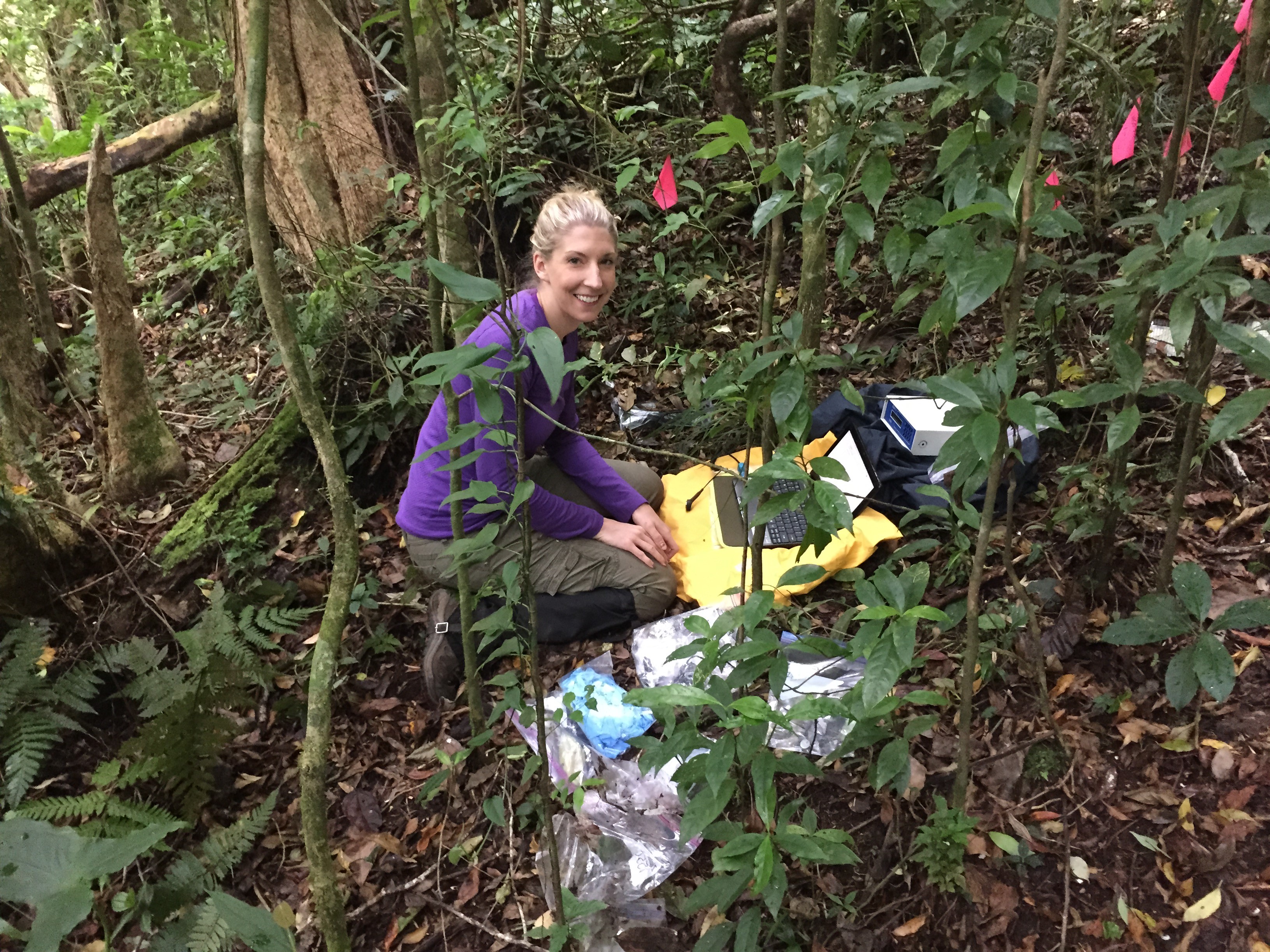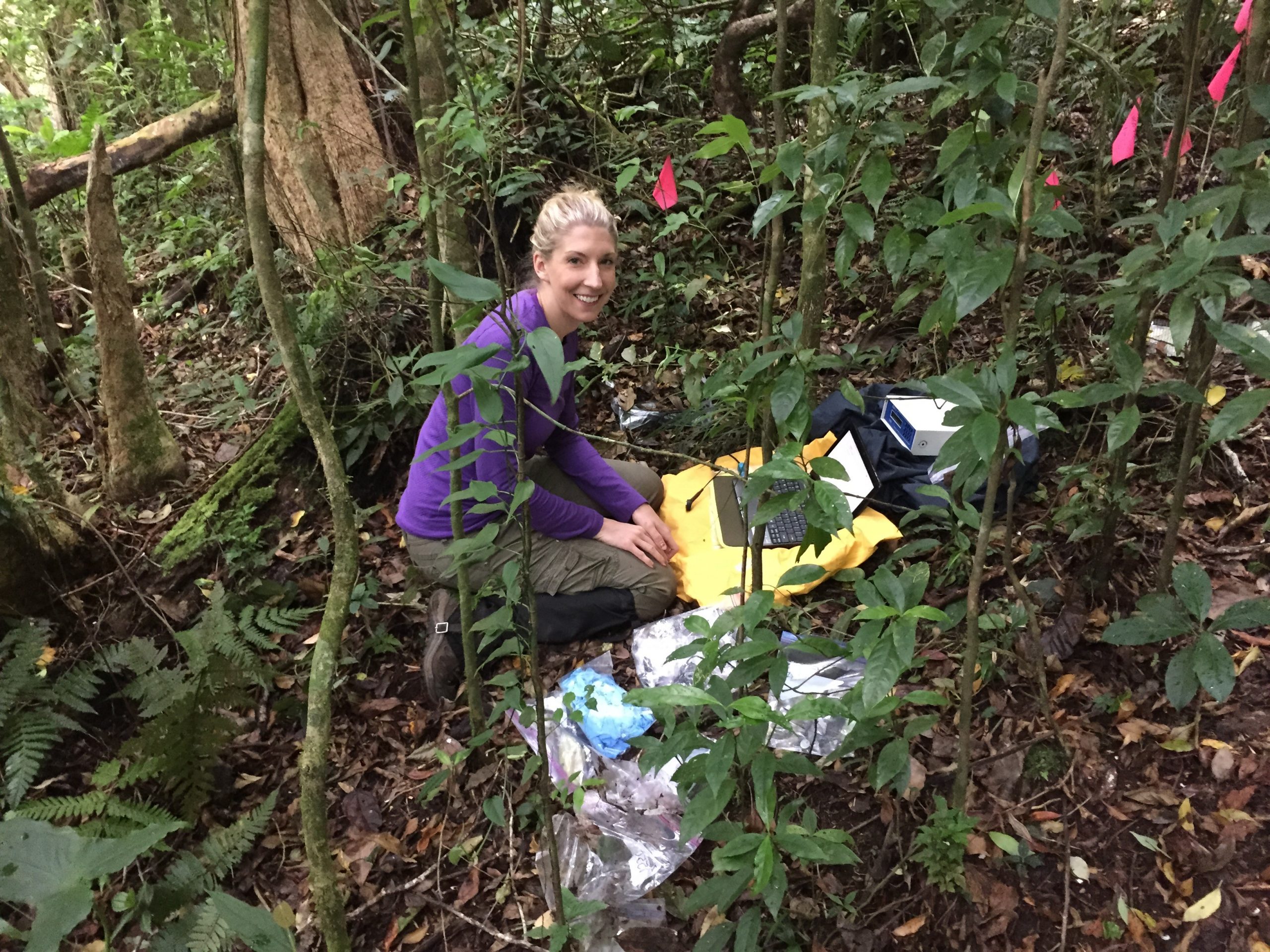
Caitlin Looby grew up in a small, rural town in New Jersey. She received her B.S. in Molecular and Cellular Biology and a minors in Chemistry and Ecology and Evolutionary Biology at the University of Connecticut. While an undergrad, Caitlin studied abroad in Costa Rica through the Council on International Educational Exchange. This was her introduction to fungi, tropics, and ecology.
Caitlin also participated in a Research Experience for Undergraduate (REU) where we compared soil communities in the temperate rainforests in Washington State and tropical rainforests in Costa Rica. Afterwards, she worked as a lab tech in Dr. Bill Eaton’s lab at Kean University in Union, NJ. Kean University offered Caitlin a Graduate Assistantship to complete a Master’s in Biotechnology Science. For her thesis work, she investigated how an antifungal plant affected belowground communities, and nutrient cycling. Fieldwork for this project was conducted in the lowland forests of Costa Rica in the Maquenque National Wildlife Refuge.
Currently, Caitlin is a PhD Candidate in Kathleen Treseder’s lab at the University of California, Irvine. She is working in a cloud forest in Costa Rica to figure out how soil fungi and decomposition will respond to warmer and drier conditions. Caitlin uses a mountain as a natural climate change experiment. She moved soil from higher elevations that are cooler and wetter to lower elevations that are warmer and drier. Soils were kept in “microbial cages” that prevent fungi from passing through. This allowed her to see how soil fungi and decomposition might change under future climate conditions.
Caitlin was fortunate to receive external funding to help support her dissertation research. Her work was supported by an EPA Science to Achieve Results Fellowship (STAR), an NSF Doctoral Dissertation Improvement Grant (DDIG), and Graduate Assistance in Areas of National Need (GAANN) Fellowships. Last year, she was also selected as a finalist to participate in the University of California Carbon Slam competition. She won third place for her poster.
How did you become a mycologist?
A circuitous path led me to fungi. I was not always interested in ecology, but after I studied abroad in Monteverde, Costa Rica I was fascinated. Microbial ecology was a way for me to combine my interest in microbiology, chemistry, and my new passion for the environment.
Ironically, when I studied abroad I did a research project on the pathogen Mycena citricolor, which infects coffee plants. This was my introduction to fungi. Once again, I found myself focusing on fungi during my Master’s work. At that point, I was delving into the literature and seeing how important fungi were. I was hooked, and needed to keep going.
Who is your mycology role model?
My mycological role model is Kathleen Treseder. She pushes the bar when it comes to asking ecological and evolutionary questions about fungi. Also, she stands for many things that are equally important to science. She actively strives to improve diversity in the sciences, and makes sure that everyone has a place and a voice.
What is your favorite fungus, and what do you like about it?
I do not want to say that a pathogenic fungus that causes devastating losses to the coffee industry, and affects many human lives is my favorite, but it gives me a sense of nostalgia. The plant pathogen Mycena citricolor was my introduction to the fungal world. And the fact that I am back in Monteverde, Costa Rica doing my dissertation on work on fungi is ironic. I had a somewhat circuitous path, but all roads led to fungi!
What is your favorite fact about fungi?
My favorite thing about fungi is that they can do almost anything. They are so important to ecosystems and fulfill many different roles. Studying fungi is also very exciting. There are so many new things that are constantly being unveiled about who they are and what they do. Also, understanding them will help us make better predications with the most pressing problem of our time—climate change.
Do you have any funny or interesting stories about field work?
To say I have some stories is an understatement. I had monkeys attack me (on at least four occasions), a caiman chase me, and watched the biggest cicada I have ever seen knock over my lab mate and mess up our LICOR readings.
But, the time I was swarmed by killer bees is definitely the most memorable. We hiked up to the top of the mountain in Monteverde. You could see them on the ground, and we knew we had to walk far away and very quickly. However, the vibrations that our steps created were enough. I was stung about 150 times.
Fortunately, there was a building at the top of this mountain. A man was inside and heard us yelling. He let us come inside, and then pulled every single bee sting out of us. A few hours later, we began the three-hour hike back down the mountain.
Ironically, this site became the focal point for my dissertation research. And it always makes the hike back down the mountain seem not so bad anymore.
You have an interest in science communication. What aspects of writing science for the public do you particularly enjoy? Are there aspects you find difficult? Do you have any advice for other students who are also interested in science communication?
I am extremely passionate about science communication, and I am actively trying to improve my skills and reach broader audiences. Currently, I write scripts for the Loh Down on Science radio program where listeners get a daily dose of science in less than two minutes. I also report on environmental news as an intern at mongabay.com. In addition, I wrote feature articles for Association for Women in Science, Cultures, and Canoe and Kayak Magazines.
For me, science writing is not only a responsibility, but also something that is fun. I enjoy learning new topics, and connecting with audiences. It is common to use analogies, and trying to find those connections between science and things that people are already familiar with is a puzzle. Fitting those puzzle pieces together is a fun challenge. And ultimately, that moment when you connect, teach someone something new, or make them appreciate a topic is extremely satisfying.
Moreover, as a scientist, I know how hard we work to make one study happen. I want to help other scientists get their work out there and appreciated.
Science communication definitely has its challenges as well. Learning to write for public is like learning a new language. You need to be very aware of your word choice. As scientists we are used to focusing on just the facts. With science communication, you have to focus on the facts and provoke the imagination.
For any students interested in science communication, the best thing you can do is practice. This is not a craft you can perfect overnight, especially because what the public needs and their perception of science is constantly changing.
Moreover, it is important to know your audience. A broader audience that is interested in science and reads about science in their free time is different that one that is not naturally interested. It is important to realize that you need to connect with these audiences differently.
It is really important to do your research. Read articles and watch presentations to see how science can be communicated successfully. Most importantly, write pieces that you would want to read in your free time, and give presentations that would make you excited.
What do you like to do in your free time? What are your hobbies?
I try to lead an active lifestyle. In my free time, I run, workout, camp, hike, and standup paddleboard. Living in Southern California is a great impetus to try a lot of new things that I had never done before. One of my favorite things to do is to paddle to an offshore kelp forest and go snorkel! Activities like this help me stay connected to the outdoors and keep me inspired. It is a reminder of why I became a scientist.


Leave a Reply